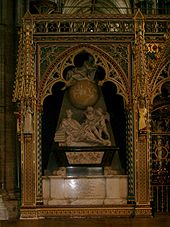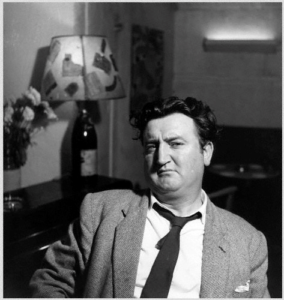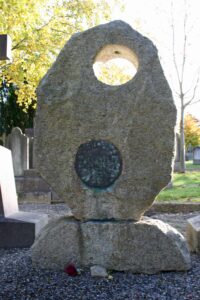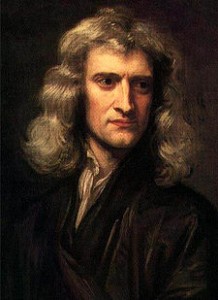On this day in 1727, physicist, mathematician, astronomer, natural philosopher, alchemist, and theologian, Sir Isaac Newton died in his sleep in Kensington, Middlesex, England at the age of 84. Born 25 December 1642 at Woolsthorpe Manor in Woolsthorpe-by-Colsterworth, a hamlet in the county of Lincolnshire. In my opinion, one of the most influential people in human history. His Philosophiæ Naturalis Principia Mathematica (Latin for “Mathematical Principles of Natural Philosophy”; usually called the Principia) (1687) lays the groundwork for most of classical mechanics and describes universal gravitation and the three laws of motion. Newton often told the story that he was inspired to formulate his theory of gravitation by watching the fall of an apple from a tree. Seems to me it is unlikely that the apple actually hit him on the head. Newton was an unorthodox Christian and actually wrote more on Biblical studies than on science and mathematics. English poet Alexander Pope wrote of Newton; “Nature and nature’s laws lay hid in night/God said “Let Newton be” and all was light.” Newton himself wrote; “If I have seen further it is by standing on the shoulders of giants.”, and “I do not know what I may appear to the world, but to myself I seem to have been only like a boy playing on the sea-shore, and diverting myself in now and then finding a smoother pebble or a prettier shell than ordinary, whilst the great ocean of truth lay all undiscovered before me.”
 The Final Footprint – Newton is entombed in Westminster Abbey. His monument is north of the entrance to the choir against the choir screen, near his tomb. Executed by the sculptor Michael Rysbrack (1694–1770) in white and grey marble with design by the architect William Kent. The monument features a figure of Newton reclining on top of a sarcophagus, his right elbow resting on several of his great books and his left hand pointing to a scroll with a mathematical design. Above him is a pyramid and a celestial globe showing the signs of the Zodiac and the path of the comet of 1680. The Latin inscription on the base translates as: “Here is buried Isaac Newton, Knight, who by a strength of mind almost divine, and mathematical principles peculiarly his own, explored the course and figures of the planets, the paths of comets, the tides of the sea, the dissimilarities in rays of light, and, what no other scholar has previously imagined, the properties of the colours thus produced. Diligent, sagacious and faithful, in his expositions of nature, antiquity and the holy Scriptures, he vindicated by his philosophy the majesty of God mighty and good, and expressed the simplicity of the Gospel in his manners. Mortals rejoice that there has existed such and so great an ornament of the human race!” Other notable Final Footprints at Westminster include; Robert Browning, Lord Byron, Charles II, Geoffrey Chaucer, Oliver Cromwell, Charles Darwin, Charles Dickens, Edward III, Edward VI, Edward The Confessor, Elizabeth I, George II, George Friederic Handel, Stephen Hawking, Henry III, Henry V, Henry VII, James I (James VI of Scotland), Samuel Johnson, Ben Jonson, Rudyard Kipling, Henry Wadsworth Longfellow, Mary I, Mary II, Mary Queen of Scots, John Milton, Laurence Olivier, Henry Purcell, Thomas Shadwell, Edmund Spenser, Lord Alfred Tennyson, Dylan Thomas, and William III.
The Final Footprint – Newton is entombed in Westminster Abbey. His monument is north of the entrance to the choir against the choir screen, near his tomb. Executed by the sculptor Michael Rysbrack (1694–1770) in white and grey marble with design by the architect William Kent. The monument features a figure of Newton reclining on top of a sarcophagus, his right elbow resting on several of his great books and his left hand pointing to a scroll with a mathematical design. Above him is a pyramid and a celestial globe showing the signs of the Zodiac and the path of the comet of 1680. The Latin inscription on the base translates as: “Here is buried Isaac Newton, Knight, who by a strength of mind almost divine, and mathematical principles peculiarly his own, explored the course and figures of the planets, the paths of comets, the tides of the sea, the dissimilarities in rays of light, and, what no other scholar has previously imagined, the properties of the colours thus produced. Diligent, sagacious and faithful, in his expositions of nature, antiquity and the holy Scriptures, he vindicated by his philosophy the majesty of God mighty and good, and expressed the simplicity of the Gospel in his manners. Mortals rejoice that there has existed such and so great an ornament of the human race!” Other notable Final Footprints at Westminster include; Robert Browning, Lord Byron, Charles II, Geoffrey Chaucer, Oliver Cromwell, Charles Darwin, Charles Dickens, Edward III, Edward VI, Edward The Confessor, Elizabeth I, George II, George Friederic Handel, Stephen Hawking, Henry III, Henry V, Henry VII, James I (James VI of Scotland), Samuel Johnson, Ben Jonson, Rudyard Kipling, Henry Wadsworth Longfellow, Mary I, Mary II, Mary Queen of Scots, John Milton, Laurence Olivier, Henry Purcell, Thomas Shadwell, Edmund Spenser, Lord Alfred Tennyson, Dylan Thomas, and William III.
RIP #OTD in 1730 the greatest French actress of her time, inspiration for playwrights, composers and poets, Adrienne Lecouvreur died in Paris aged 37. she was denied religious rites and buried in a ditch near the banks of the Seine
 On this day in 1964, Irish poet, short story writer, novelist and playwright Brendan Behan died after collapsing at the Harbour Lights bar in Dublin at the age of 41. Born Brendan Francis Aidan Behan (christened Francis Behan) on 9 February 1923 in . Behan wrote in both English and Irish. In my opinion, he was one of the greatest Irish writers of all time.
On this day in 1964, Irish poet, short story writer, novelist and playwright Brendan Behan died after collapsing at the Harbour Lights bar in Dublin at the age of 41. Born Brendan Francis Aidan Behan (christened Francis Behan) on 9 February 1923 in . Behan wrote in both English and Irish. In my opinion, he was one of the greatest Irish writers of all time.
An Irish republican and a volunteer in the Irish Republican Army, Behan was born in Dublin into a staunchly republican family becoming a member of the IRA’s youth organisation Fianna Éireann at the age of fourteen. There was also a strong emphasis on Irish history and culture in the home, which meant he was steeped in literature and patriotic ballads from an early age. Behan eventually joined the IRA at sixteen, which led to his serving time in a borstal youth prison in the United Kingdom and he was also imprisoned in Ireland. During this time, he took it upon himself to study and he became a fluent speaker of the Irish language. Subsequently released from prison as part of a general amnesty given by the Fianna Fáil government in 1946, Behan moved between homes in Dublin, Kerry and Connemara, and also resided in Paris for a time.
In 1954, Behan’s first play The Quare Fellow, was produced in Dublin. It was well received; however, it was the 1956 production at Joan Littlewood’s Theatre Workshop in Stratford, London, that gained Behan a wider reputation. This was helped by a famous drunken interview on BBC television with Malcolm Muggeridge. In 1958, Behan’s play in the Irish language An Giall had its debut at Dublin’s Damer Theatre. Later, The Hostage, Behan’s English-language adaptation of An Giall, met with great success internationally. Behan’s autobiographical novel, Borstal Boy, was published the same year and became a worldwide best-seller and by 1955, Behan had married Beatrice ffrench Salkeld.
By the early 1960s, Behan reached the peak of his fame. He spent increasing amounts of time in New York, famously declaring, “To America, my new found land: The man that hates you hates the human race.” By this point, Behan began spending time with people including Harpo Marx and Arthur Miller and was followed by a young Bob Dylan. He turned down his invitation to the inauguration of John F. Kennedy. He had long been a heavy drinker (describing himself, on one occasion, as “a drinker with a writing problem” and claiming “I only drink on two occasions—when I’m thirsty and when I’m not”) and developed diabetes in the early 1950s but this was not diagnosed until 1956. His Brendan Behan’s New York and Confessions of an Irish Rebel received little praise. He briefly attempted to combat this by a sober stretch while staying at Chelsea Hotel in New York, but once again turned back to drink.
The Final Footprint
 He was given a full IRA guard of honour, which escorted his coffin. It was described by several newspapers as the biggest Irish funeral of all time after those of Michael Collins and Charles Stewart Parnell. He is interred at Glasnevin Cemetery in Dublin. Other notable final footprints at Glasnevin include; Michael Collins, Maud Gonne, Gerard Manley Hopkins, and Seán MacBride.
He was given a full IRA guard of honour, which escorted his coffin. It was described by several newspapers as the biggest Irish funeral of all time after those of Michael Collins and Charles Stewart Parnell. He is interred at Glasnevin Cemetery in Dublin. Other notable final footprints at Glasnevin include; Michael Collins, Maud Gonne, Gerard Manley Hopkins, and Seán MacBride.
#RIP #OTD in 1994 writer, humorist, newspaper columnist (Atlanta Journal-Constitution), Lewis Grizzard died from complications of his 4th heart-valve surgery in Atlanta, aged 47. Some of his cremated remains scattered at the 50-yard line of Sanford Stadium, University of Georgia
#RIP #OTD in 2020 singer (“Ruby, Don’t Take Your Love to Town”, “Lucille”, “Coward of the “County”, “The Gambler”), songwriter, musician, actor, entrepreneur Kenny Rogers died while under hospice care at his home in Sandy Springs, Georgia, aged 81. Oakland Cemetery in Atlanta
Have you planned yours yet?
Follow us on twitter @RIPTFF
http://thefinalfootprint.com/2023/03/20/day-in-history-20-march-sir-isaac-newton/(opens in a new tab) http://thefinalfootprint.com/2023/03/20/day-in-history-20-march-sir-isaac-newton/


